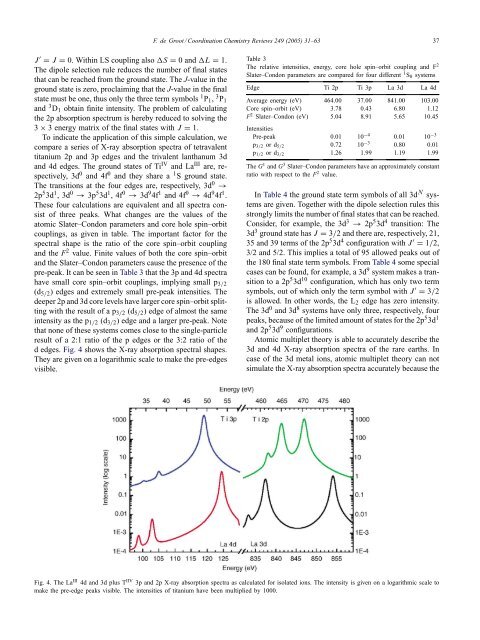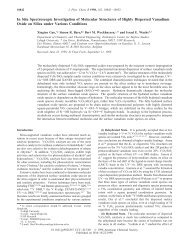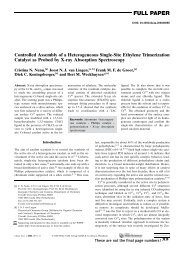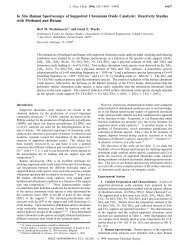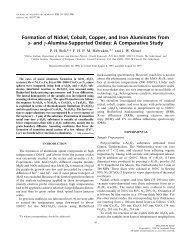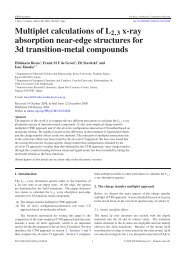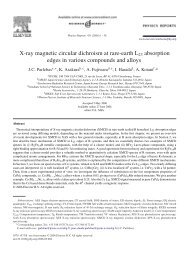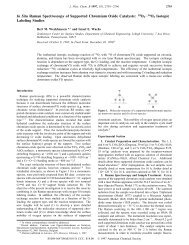36 F. de Groot / Coord<strong>in</strong>ation <strong>Chemistry</strong> Reviews 249 (2005) 31–6310 ×9/2 ×8/3. Because there is a symmetry equivalence ofholes <strong>and</strong> electrons, the pairs 3d 2 –3d 8 ,3d 3 –3d 7 , etc. haveexactly the same term symbols. The general formula to determ<strong>in</strong>ethe degeneracy of a 3d N configuration is:( ) 10 10!=N (10 − N)!N!The 2p X-<strong>ray</strong> absorption edge (2p → 3d transition) isoften studied for the 3d transition metal series, <strong>and</strong> it providesa wealth of <strong>in</strong>formation. Crucial for its underst<strong>and</strong><strong>in</strong>gare the configurations of the 2p 5 3d N f<strong>in</strong>al states. The termsymbols of the 2p 5 3d N states are found by multiply<strong>in</strong>g theconfigurations of 3d N with a 2 P term symbol. The total degeneracyof a 2p 5 3d N state is six times the degeneracy of3d N . For example, a 2p 5 3d 5 configuration has 1512 possiblestates. Analysis shows that these 1512 states are divided<strong>in</strong>to 205 term symbols, imply<strong>in</strong>g <strong>in</strong> pr<strong>in</strong>ciple 205 possiblef<strong>in</strong>al states. Whether all these f<strong>in</strong>al states actually have f<strong>in</strong>ite<strong>in</strong>tensity depends on the selection rules.1.3.2. Matrix elementsThe term symbol of a 3d N configuration describes thesymmetry aspects, but it does not say anyth<strong>in</strong>g about its relativeenergy. The relative energies of the different terms aredeterm<strong>in</strong>ed by calculat<strong>in</strong>g the matrix elements of these stateswith the effective electron–electron <strong>in</strong>teraction H ee ′ <strong>and</strong> thesp<strong>in</strong>–orbit coupl<strong>in</strong>g H ls . The general formulation of the matrixelements of the effective electron–electron <strong>in</strong>teraction isgiven as:〈2S+1 ∣ ∣∣∣ e 2 ∣ 〉 ∣∣∣L 2S+1 J L J = ∑ f k F k + ∑ g k G kr 12kkF i (f i ) <strong>and</strong> G i (g i ) are the Slater–Condon parameters for, respectively,the radial (angular) part of the direct Coulombrepulsion <strong>and</strong> the Coulomb exchange <strong>in</strong>teraction. f i <strong>and</strong> g iare non-zero only for certa<strong>in</strong> values of i, depend<strong>in</strong>g on theconfiguration. The direct Coulomb repulsion f 0 is alwayspresent <strong>and</strong> the maximum value for i equals two times thelowest value of l. The exchange <strong>in</strong>teraction g i is present onlyfor electrons <strong>in</strong> different shells. For g k , i is even if l 1 + l 2 iseven, <strong>and</strong> i is odd if l 1 + l 2 is odd. The maximum value ofi equals l 1 + l 2 . For 3d-states, it is important to note that a3d N configuration conta<strong>in</strong>s f 0 , f 2 <strong>and</strong> f 4 Slater–Condon parameters.The f<strong>in</strong>al state 2p 5 3d N +1 configuration conta<strong>in</strong>sf 0 , f 2 , f 4 , g 1 , <strong>and</strong> g 3 Slater–Condon parameters.Fora3d 2 configuration, we found the five term symbols1 S, 3 P, 1 D, 3 F <strong>and</strong> 1 G. f 0 is equal to the number of pairsN(N − 1)/2 ofN electrons, i.e. it is equal to 1 for twoelectrons. The Slater–Condon parameters F 2 <strong>and</strong> F 4 haveapproximately a constant ratio: F 4 = 0.62, F 2 . In case of the3d transition metal ions, F 2 is approximately equal to 10 eV.This gives for the five term symbols of the 3d 2 configuration,respectively, 3 Fat−1.8 eV, 1 Dat−0.1 eV, 3 Pat+0.2 eV,1 Gat+0.8 eV <strong>and</strong> 1 Sat+4.6 eV. The 3 F term symbol hasthe lowest energy <strong>and</strong> it is the ground state of a 3d 2 system.This is a confirmation of the Hunds rules, which will bediscussed below. The three states 1 D, 3 P <strong>and</strong> 1 G are close<strong>in</strong> energy some 1.7–2.5 eV above the ground state. The 1 Sstate has a high energy of 6.4 eV above the ground state, thereason be<strong>in</strong>g that two electrons <strong>in</strong> the same orbital stronglyrepel each other.For three <strong>and</strong> more electrons the situation is considerablymore complex. It is not straightforward to write downan anti-symmetrized three-electron wave function. It can beshown that the three-electron wave function can be built fromtwo-electron wave functions with the use of the so-called coefficientsof fractional parentage. For a partly filled d-b<strong>and</strong>,the term symbol with the lowest energy is given by theso-called Hunds rules. Based on experimental <strong>in</strong>formationHund formulated three rules to determ<strong>in</strong>e the ground stateofa3d N configuration. The three Hunds rules are the follow<strong>in</strong>g.1. Term symbols with maximum sp<strong>in</strong> S are lowest <strong>in</strong> energy.2. Among these terms, the one with the maximum orbitalmoment L is lowest.3. In the presence of sp<strong>in</strong>–orbit coupl<strong>in</strong>g, the lowest termhas J =|L − S| if the shell is less than half full <strong>and</strong>J = L + S if the shell is more than half full.A configuration has the lowest energy if the electrons areas far apart as possible. The first Hunds rule ‘maximum sp<strong>in</strong>’can be understood from the Pauli pr<strong>in</strong>ciple: electrons withparallel sp<strong>in</strong>s must be <strong>in</strong> different orbitals, which on overallimplies larger separations, hence lower energies. This is forexample, evident for a 3d 5 configuration, where the 6 S statehas its five electrons divided over the five sp<strong>in</strong>-up orbitals,which m<strong>in</strong>imizes their repulsion. In case of 3d 2 , the secondHunds rule implies that the 3 F term symbol is lower thanthe 3 P-term symbol, because the 3 F wave function tends tom<strong>in</strong>imize electron repulsion.1.3.3. X-<strong>ray</strong> absorption spectra described with atomicmultipletsWe start with the description of closed shell systems. The2p X-<strong>ray</strong> absorption process excites a 2p core electron <strong>in</strong>tothe empty 3d shell <strong>and</strong> the transition can be described as2p 6 3d 0 → 2p 5 3d 1 . The ground state has 1 S 0 symmetry <strong>and</strong>we f<strong>in</strong>d that the term symbols of the f<strong>in</strong>al state are 1 P 1 ,1 D 2 , 1 F 3 , 3 P 012 , 3 D 123 <strong>and</strong> 3 F 234 . The energies of the f<strong>in</strong>alstates are affected by the 2p3d Slater–Condon parameters,the 2p sp<strong>in</strong>–orbit coupl<strong>in</strong>g <strong>and</strong> the 3d sp<strong>in</strong>–orbit coupl<strong>in</strong>g.The X-<strong>ray</strong> absorption transition matrix elements to be calculatedare:I XAS ∝〈3d 0 [ 1 S 0 ] |⃗r. [ 1 P 1 ] |2p5 3d 1 [ 1,3 PDF] 〉2The 12 f<strong>in</strong>al states are built from the 12 term symbols,with the restriction that the states with the same J-valueblock out <strong>in</strong> the calculation. The symmetry of the dipoletransition is given as 1 P 1 , accord<strong>in</strong>g to the dipole selectionrules, which state that J =±1 or 0, with the exception of
F. de Groot / Coord<strong>in</strong>ation <strong>Chemistry</strong> Reviews 249 (2005) 31–63 37J ′ = J = 0. With<strong>in</strong> LS coupl<strong>in</strong>g also S = 0 <strong>and</strong> L = 1.The dipole selection rule reduces the number of f<strong>in</strong>al statesthat can be reached from the ground state. The J-value <strong>in</strong> theground state is zero, proclaim<strong>in</strong>g that the J-value <strong>in</strong> the f<strong>in</strong>alstate must be one, thus only the three term symbols 1 P 1 , 3 P 1<strong>and</strong> 3 D 1 obta<strong>in</strong> f<strong>in</strong>ite <strong>in</strong>tensity. The problem of calculat<strong>in</strong>gthe 2p absorption spectrum is hereby reduced to solv<strong>in</strong>g the3 × 3 energy matrix of the f<strong>in</strong>al states with J = 1.To <strong>in</strong>dicate the application of this simple calculation, wecompare a series of X-<strong>ray</strong> absorption spectra of tetravalenttitanium 2p <strong>and</strong> 3p edges <strong>and</strong> the trivalent lanthanum 3d<strong>and</strong> 4d edges. The ground states of Ti IV <strong>and</strong> La III are, respectively,3d 0 <strong>and</strong> 4f 0 <strong>and</strong> they share a 1 S ground state.The transitions at the four edges are, respectively, 3d 0 →2p 5 3d 1 ,3d 0 → 3p 5 3d 1 ,4f 0 → 3d 9 4f 1 <strong>and</strong> 4f 0 → 4d 9 4f 1 .These four calculations are equivalent <strong>and</strong> all spectra consistof three peaks. What changes are the values of theatomic Slater–Condon parameters <strong>and</strong> core hole sp<strong>in</strong>–orbitcoupl<strong>in</strong>gs, as given <strong>in</strong> table. The important factor for thespectral shape is the ratio of the core sp<strong>in</strong>–orbit coupl<strong>in</strong>g<strong>and</strong> the F 2 value. F<strong>in</strong>ite values of both the core sp<strong>in</strong>–orbit<strong>and</strong> the Slater–Condon parameters cause the presence of thepre-peak. It can be seen <strong>in</strong> Table 3 that the 3p <strong>and</strong> 4d spectrahave small core sp<strong>in</strong>–orbit coupl<strong>in</strong>gs, imply<strong>in</strong>g small p 3/2(d 5/2 ) edges <strong>and</strong> extremely small pre-peak <strong>in</strong>tensities. Thedeeper 2p <strong>and</strong> 3d core levels have larger core sp<strong>in</strong>–orbit splitt<strong>in</strong>gwith the result of a p 3/2 (d 5/2 ) edge of almost the same<strong>in</strong>tensity as the p 1/2 (d 3/2 ) edge <strong>and</strong> a larger pre-peak. Notethat none of these systems comes close to the s<strong>in</strong>gle-particleresult of a 2:1 ratio of the p edges or the 3:2 ratio of thed edges. Fig. 4 shows the X-<strong>ray</strong> absorption spectral shapes.They are given on a logarithmic scale to make the pre-edgesvisible.Table 3The relative <strong>in</strong>tensities, energy, core hole sp<strong>in</strong>–orbit coupl<strong>in</strong>g <strong>and</strong> F 2Slater–Condon parameters are compared for four different 1 S 0 systemsEdge Ti 2p Ti 3p La 3d La 4dAverage energy (eV) 464.00 37.00 841.00 103.00Core sp<strong>in</strong>–orbit (eV) 3.78 0.43 6.80 1.12F 2 Slater–Condon (eV) 5.04 8.91 5.65 10.45IntensitiesPre-peak 0.01 10 −4 0.01 10 −3p 3/2 or d 5/2 0.72 10 −3 0.80 0.01p 1/2 or d 3/2 1.26 1.99 1.19 1.99The G 1 <strong>and</strong> G 3 Slater–Condon parameters have an approximately constantratio with respect to the F 2 value.In Table 4 the ground state term symbols of all 3d N systemsare given. Together with the dipole selection rules thisstrongly limits the number of f<strong>in</strong>al states that can be reached.Consider, for example, the 3d 3 → 2p 5 3d 4 transition: The3d 3 ground state has J = 3/2 <strong>and</strong> there are, respectively, 21,35 <strong>and</strong> 39 terms of the 2p 5 3d 4 configuration with J ′ = 1/2,3/2 <strong>and</strong> 5/2. This implies a total of 95 allowed peaks out ofthe 180 f<strong>in</strong>al state term symbols. From Table 4 some specialcases can be found, for example, a 3d 9 system makes a transitionto a 2p 5 3d 10 configuration, which has only two termsymbols, out of which only the term symbol with J ′ = 3/2is allowed. In other words, the L 2 edge has zero <strong>in</strong>tensity.The 3d 0 <strong>and</strong> 3d 8 systems have only three, respectively, fourpeaks, because of the limited amount of states for the 2p 5 3d 1<strong>and</strong> 2p 5 3d 9 configurations.Atomic multiplet theory is able to accurately describe the3d <strong>and</strong> 4d X-<strong>ray</strong> absorption spectra of the rare earths. Incase of the 3d metal ions, atomic multiplet theory can notsimulate the X-<strong>ray</strong> absorption spectra accurately because theFig. 4. The La III 4d <strong>and</strong> 3d plus T IIV 3p <strong>and</strong> 2p X-<strong>ray</strong> absorption spectra as calculated for isolated ions. The <strong>in</strong>tensity is given on a logarithmic scale tomake the pre-edge peaks visible. The <strong>in</strong>tensities of titanium have been multiplied by 1000.


